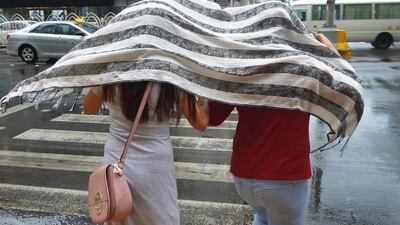ABU DHABI // A meteorologist with the nation's forecaster says cloud seeding operations over the UAE played a part in last month's record rainfall.
Between January and the end of March, Sufian Farrah, a meteorologist and cloud seeding expert at the National Centre for Meteorology and Seismology, said 77 seeding operations took place – more than three times as many as during the same period last year.
"We covered most of the available clouds in the country, so the rainfall increased," he said.
While it was not possible to determine the precise success rate of operations, Mr Farrah said the increase contributed to greater amounts of rainfall than under normal conditions.
Only clouds that are expected to generate rain would be targeted, he said.
"Even if we didn't carry out any operations it would rain, but the objective of cloud seeding is rain enhancement, and most of the clouds that are subject to seeding will generate rain," he said.
____________________
Heads in the clouds: how the UAE hopes to make rain for the good of the world
___________________
On March 9, the weather agency measured 287 millimetres of rainfall in 24 hours in an area between Dubai and Al Ain – the highest level since official record keeping began in 1977.
Each millimetre translates to one litre over an area of one square metre, Mr Farrah said.
"This amount usually would not even be recorded in one year," he said.
Annual rainfall rarely exceeds 120mm, with the previous record for a 24-hour period being 178.9mm, recorded at Fujairah International Airport on December 11, 1995.
Formal record keeping by the NCMS began in 2001 with its first weather station. The agency operates 74 stations.
Last month, parts of the UAE experienced intense weather, including thunderstorms and winds that reached 126 kilometres per hour, toppling trees and damaging buildings.
In the first three months of last year, 20 seeding operations were carried out, with 158 completed over the course of the year.
Operations typically take between two and three hours, and involve a twin-propeller plane – the NCMS has six planes dedicated to rain enhancement — pilots fire salt crystals into selectd clouds.
The goal is to increase condensation within the cloud and trigger precipitation.
A study carried out by the forecaster found that the best candidate clouds for seeding form in the summer, over the eastern and south-western regions of the country.
Last year, the NCMS launched a formal research programme for rain-enhancement science that aimed to address water security.
"Due to its arid nature, this country has always been concerned by the issue of water security, leading the Government to devise strategies to put sustainability at the core of its economic development," wrote Alya Saeed Al Mazrouei, the programme's director, earlier this year.
The programme includes opportunities for research teams to submit project proposals for a chance to receive a US$5 million (Dh18m) grant and contribute to rain-enhancement science.
esamoglou@thenational.ae

Cloud seeding operations over the UAE ‘played a part in record March rainfall’
A meteorologist with the nation’s forecaster says cloud seeding operations over the UAE played a part in last month’s record rainfall.
Most popular today
